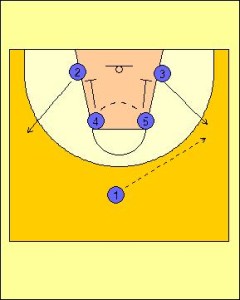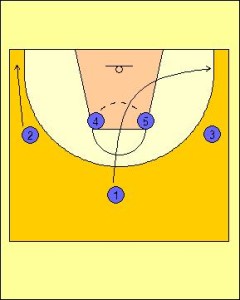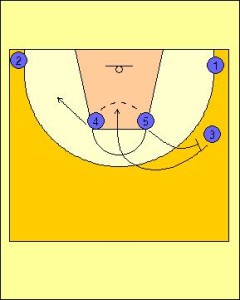Introduction to the Box Offense
The Box Offense began to take favour in the 1970’s as basketball began to become a more free flowing game. As the players became both quicker and faster, there needed to be an offense created that allowed for quick shots that were still from high percentage areas on the floor. The box offense allowed fast paced teams to get the kinds of shots they wanted, while also fitting well into the offensive schemes of more half court oriented teams.
As players developed a wider range of technical skills, there also had to be an offense that was created to accommodate for the abilities of these players. No one coach is attributed with the creation of the box offense, but a collective of collegiate and high school coaches began using the offense after the 1960’s. The box offense has stood the test of time and is still considered one of the most popular offenses in the game of basketball. At any stadium around the world you can see the box formation in action, or at the very least the starting formation.
The box offense is a player’s offense. It is particularly popular amongst players because it gives them a level of offensive freedom that is not always readily available in many offensive systems. Coaches and players like the box offense because it’s relatively easy to implement and add variations to. It’s easy to create an isolation opportunity for either a guard or a forward, and either in the post or on the perimeter. In this way a defensive player can be targeted and their weaknesses exposed to the benefit of the offensive team.
Most offenses have to be run to a certain point in order to get the kind of effectiveness that many coaches desire. However, the box offense flips this notion on its head, with its simplicity the offense can be used for juniors and seniors alike. The box offense is run an all levels, its simplest forms being staples at the high schools, and more complex forms appearing at the collegiate and professional levels.
The box offense’s strong point is that it can create isolation opportunities for a team’s best offensive player. That means the player who can create for himself and other players on the court can quickly get the ball in a spot on the floor that is most advantageous to them. For a forward, this position might be on the block, and for a guard, this position might be on the perimeter. However because of the starting formation for the box offense a player can potentially receive the ball in any position on the floor without too much of an issue.
The offense also seamlessly transitions into other offenses or simple schemes, with perimeter players catching the ball on the wing and then immediately going into a pick and roll scenario. There are any number variations that are possible from the standard set-up of the box offense.
Problems with the box offense start when examining the standard play options. These options are often very simplistic and because of this the box offense if not partnered with a number of variations, quick hitter and other trick plays can easily scouted.
As a coach facing the box offense you need to have scouted the opposition prior to the game. This information will look to move players into favoured scoring positions. By knowing what these are for key individuals the offense can be limited by good defensive principles of denial and jumping to the pass when off the ball.
Because of the starting formation denial of players lifting to the receivers spots can cause the offense to stall. When defending against a team utilising the box offense instruct your players to play strong help defence because the offensive players are often condensed and so the distance for recovery their players is usually shorter. Your defensive players must also carry their hands to help limit the tight passing lanes within the box offense.

In the box offense, the offensive players begin in a box set.
Players are positioned on both high posts and both low posts.
The ball handler (One) starts at the top of the key in the Point Position.

The post players (Four and Five) set down screens for the perimeter players (Two and Three), who cut out to the wings.
The ball can go to either side, but in this instance the Point Guard (One) passes to the Small Forward (Three).

After the Small Forward (Three) receives the ball, the Point Guard (One) cuts to the strong side corner.
The weak side perimeter player (Two) drops to the weak side corner.
The Small Forward (Three) with the ball has a number of options:
- He can call for the Centre to move to the weak side block and isolate.
- He can call for a pick and roll with the centre (5).
- He can throw a skip pass to the perimeter player (Two) in the weak side corner.

In this case, the Small Forward (Three) takes the screen from the Centre (Five) and runs a pick and roll.
The Power Forward (Four) rotates to the short corner to create space.







This is an offense used against man to man defense, correct?
Hi Coach,
Yes, this offended is intended to be used against a man to man defense. However, it is probably worth noting that many offence are universal in their application (man to man, zone or junk) it is the specific space the offensive player moves into that allows for this change in application.
For example, changing a cut to open space to a deep seal might be all that is needed for an offence to effective against a different defensive strategy.
Yes, but there are small adjustments that can be made (like most offenses) that could make this also suitable against a zone defense